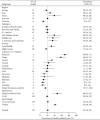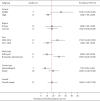Prevalence of the Use of Herbal Medicines among Patients with Cancer: A Systematic Review and Meta-Analysis
- PMID: 34055029
- PMCID: PMC8149249
- DOI: 10.1155/2021/9963038
Prevalence of the Use of Herbal Medicines among Patients with Cancer: A Systematic Review and Meta-Analysis
Abstract
Background: Although herbal medicines are used by patients with cancer in multiple oncology care settings, the magnitude of herbal medicine use in this context remains unclear. The purpose of this review was to establish the prevalence of herbal medicine use among patients with cancer, across various geographical settings and patient characteristics (age and gender categories).
Methods: Electronic databases that were searched for data published, from January 2000 to January 2020, were Medline (PubMed), Google Scholar, Embase, and African Index Medicus. Eligible studies reporting prevalence estimates of herbal medicine use amongst cancer patients were pooled using random-effects meta-analyses. Studies were grouped by World Bank region and income groups. Subgroup and meta-regression analyses were performed to explore source of heterogeneity.
Results: In total, 155 studies with data for 809,065 participants (53.95% female) met the inclusion criteria. Overall, the pooled prevalence of the use of herbal medicine among patients with cancer was 22% (95% confidence interval (CI): 18%-25%), with the highest prevalence estimates for Africa (40%, 95% CI: 23%-58%) and Asia (28%, 95% CI: 21%-35%). The pooled prevalence estimate was higher across low- and middle-income countries (32%, 95% CI: 23%-42%) and lower across high-income countries (17%, 95% CI: 14%-21%). Higher pooled prevalence estimates were found for adult patients with cancer (22%, 95% CI: 19%-26%) compared with children with cancer (18%, 95% CI: 11%-27%) and for female patients (27%, 95% CI: 19%-35%) compared with males (17%, 95% CI: 1%-47%).
Conclusion: Herbal medicine is used by a large percentage of patients with cancer use. The findings of this review highlight the need for herbal medicine to be integrated in cancer care.
Copyright © 2021 John Baptist Asiimwe et al.
Conflict of interest statement
The authors declare that they have no conflicts of interest.
Figures







References
-
- WHO. Geneva, Switzerland: WHO; 2014. World Cancer Report.
-
- Yarney J., Donkor A., Opoku S. Y., et al. Characteristics of users and implications for the use of complementary and alternative medicine in Ghanaian cancer patients undergoing radiotherapy and chemotherapy: a cross- sectional study. BMC Complementary and Alternative Medicine. 2013;13(16):2–9. doi: 10.1186/1472-6882-13-16. - DOI - PMC - PubMed
Publication types
Grants and funding
LinkOut - more resources
Full Text Sources
Other Literature Sources
Miscellaneous

